To any of you who havent stumbled on me before let me take a moment to say Hi & welcome!
I asked Twitter what they would like me to blog about & gave 3 options, this was the one that quite frankly came out streets ahead, which of course is the one I was most dreading writing.
This may sound odd coming from me but the concept of a garden totally skewed towards the winter months was something that until recently hadn’t really come up in my radar. Why? I’m not quite sure?
In most of our gardens it would be nigh on impossible to dedicate an entire garden or even section of garden to just plants that look or smell good in the winter. Most urban gardens just don’t have the scale needed for this but what we can do if we want to incorporate this into our lives is perhaps take one or two of the choicest plants and use those.
A common misconception with gardens in winter is everything stops, nothing grows, nothing changes and nothing flowers. This simply isn’t true. Winter can be an amazing time to be out in the garden and if planned correctly can be full of scent, colour and flowers from December through to the end of February when Spring creeps up on quiet feet.
Part 1 (which can be viewed here The winter garden – part 1 )looked at the trees and shrubs which make the cold dark days a little brighter. In part 2 we will look at the smaller denizens and its structure.
Ground cover
Eranthis hyemalis – Winter Aconite

I’ll be the first to admit that im not totally in love with acid yellow flowers but for the bravest intrepid bees that venture out on the odd bright warmish day we get in the winter these are absolute stars! Bees are attracted to yellow flowers over any other colour, weirdly they apparently see it as blue (im not sure who worked this out or how?) which means also that blue flowers work well for them too… but im digressing again!
Eranthis is a member of the buttercup family (Ranunculacea) and like a lot of plants can be poisonous. Dont panic, it’s not going to jump out of the flower bed and force itself down your throat… at least I don’t think so? It, like all plants, needs to be treated with respect. I know a lot of people get extraordinarily worried about poisonous plants being grown in their gardens but a good rule of thumb is just dont eat them! Teach your pets and children not to eat stuff and everyone is happy. I grew up in a garden filled with toxic plants as did our pets, none of us died. My mum taught us from before I can remember to treat plants with respect. Too often I see children in public gardens running over carefully weeded & dug borders, snapping plants & generally running riot. Is this a new thing? I know that we as children would have been given a sharp clart for wrecking someones hard work in this way never mind the potential danger of running into a plant with virtual teeth… ooh, I think im having a soap box moment… apologies, I’ll get back to the Aconite!

Eranthis is a european native and has been known and used for centuries. Gerards Herbal, one of my favourite “mad” books includes it under the title of ‘English wolfsbane’ and gives it the title of Aconitum hyemale due to its leaf shape and seed head which are not dissimilar to those of the Aconite family. It grows from tubers in deciduous woodland so is tolerant of a little shade.
Erica – Winter Heather
As the name suggests the Erica family has slightly special needs in the form of ericaceous (acidic) soil but if you’re a gardener who lives on chalk, fear not you can easily grow them in pots of ericaceous compost but the Erica family is more tolerant than the Calluna family of Heathers of less acidic conditions.

Unbelievably, considering I worked in a garden which had an entire area devoted to Heathers called ‘The Policy’ ( I never did find out the reason it was called this, supposedly it was because that’s the Scottish name for a heather garden? I’ve always understood thats the highlands? 😉 ) I haven’t ever really got excited about them and consequently haven’t taken many pictures of them.

That said when you get a good display together it can be very impressive, even the odd Erica dotted around can be exceptional in its small way. So a few Heather facts!
Calluna is a distinctively different species from Erica as it flowers in autumn as opposed to Erica which flowers in spring but there are many that will flower a bit earlier and make a wonderful addition to your winter garden. In particular look out for cultivars of Erica carnea, Erica x darleyensis and Erica erigena.
One of the most important things for keeping your heathers looking good is consistent pruning. This should be done directly after flowering, if you have a small patch I would use secateurs (but be very careful not to catch your other hand with them, it’s easily done!) for a larger patch shears or even a hedge cutter. Cut right back to the point where you can still see growing leaves but a warning, don’t cut into old wood. like many small shrubs they won’t regenerate! Its well worth doing though as it keeps your heathers youthful and giving a good, compact flower display.
Snowdrops

Now THIS is where i get a bit* excited!
*a lot
I’m not even sure I can put my finger on the moment this happened exactly, maybe it was the moment i was given some double snowdrops from ryton, maybe even before then? I can tell you when my appreciation became full-blown though, working with Quentin Stark at Hole Park, his love of them is infectious. A true Galanthophile!


I don’t even count myself as a Galanthophile more an avid lover of these beautiful, delicate, transient, denizens of our gardens that hail the coming of spring. I’m unable to tell one from the other… unless its ‘Mr grumpy’… or ‘flora pleno’…. but then they’re easy!
There are also some amazingly beautiful ones with a yellow ovary instead of the usual green or glaucous tint. 2 of the most easy of these to get hold of & the most reliable are G. plicatus ‘Wendy’s Gold’ and G. nivalis ‘Sandersii’ syn.’Lutescens’. The gold snowdrops can be a little unstable and subject to reversion but that makes them all the more desirable to collectors. Their rarity pushes the price they can command and if you can breed a stable form you could almost retire on it. There is one I would love to see in the flesh and that’s a double yellow called Galanthus nivalis ‘Lady Elphinstone’ Cadwalader, amazing! For all I’ve just raved about these yellow snowdrops I’ve never actually seen any! I’m hoping this will change this year though as Im going to Chelsea physic gardens snowdrop fair.
A quick latin bit! Galanthus literally means Milk Flower, love it, Gala = Milk & Anthos, the second part slightly mangled to fit = Flower. When followed by nivalis = ‘of the snow’

I wish I could remember everything Quentin tried to teach me so I could relay it to you with confidence but I do remember clearly the passion he spoke about them with, which somehow communicated itself to me to the extent that you will see me crawling round on the ground, camera in hand squinting to try to spot the miniscule differences between one little white flower and another almost exactly identical little white flower.
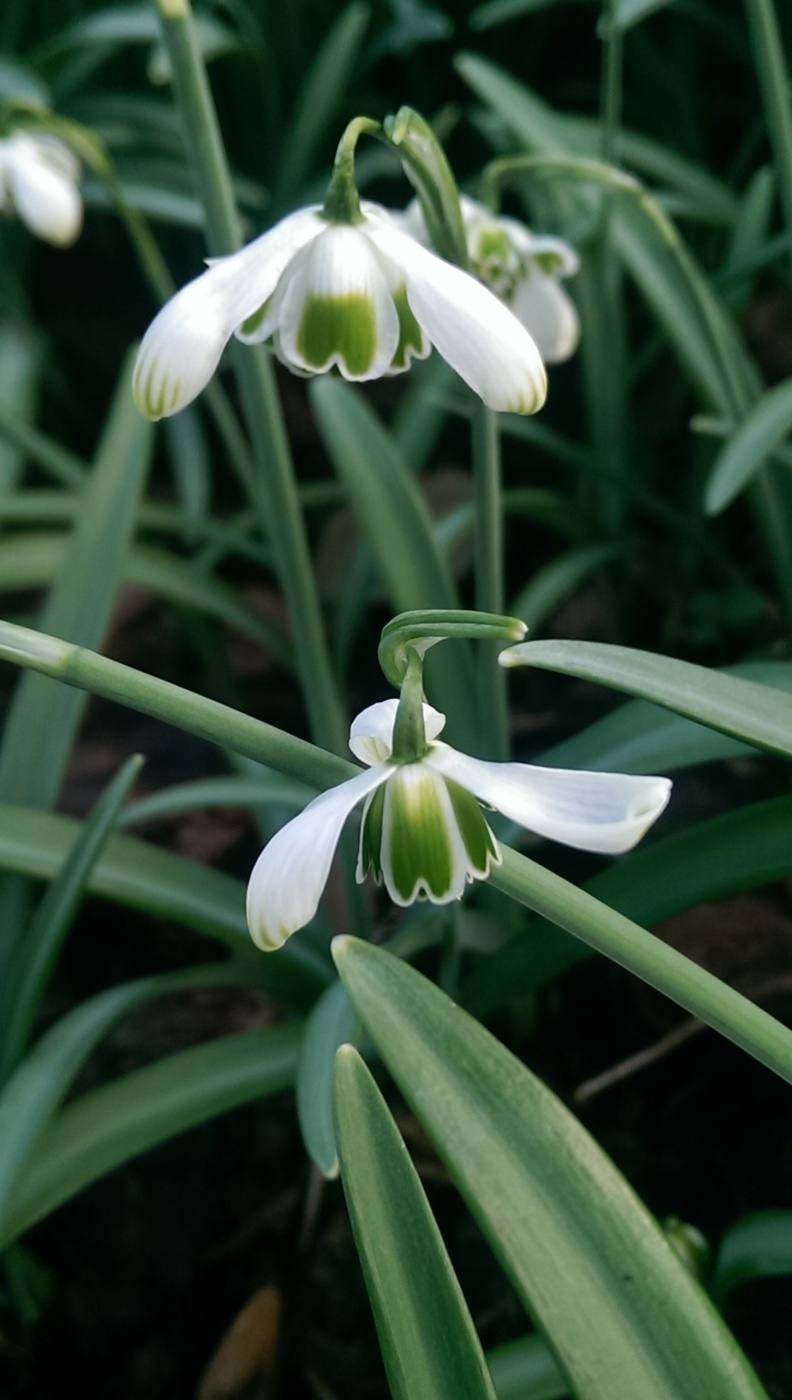
And there ARE differences! The picture above shows that clearly and compare to the one below…
Snowdrops aren’t native to Britain though as much as we think of them as a naturalised wildflower. Some think that the Romans introduced them, others will tell you they weren’t introduced from Europe till the 16th or possibly 15th Century, depending on who’s telling you.
Leucojum vernum

Sometimes called the giant snowdrop (or spring snowflake) as it stands at about 30cm and being related, Leucojum flowers slightly later which gives you a marvellous continuity when planning your garden. They will tolerate shade quite happily & waterlogged soils a rare and valuable trait for difficult areas.
They will flower right through from February till April giving bees a good source of nectar. Various members of the Leucojum genus have recently been moved to the Acis genus but Leucojum vernum & it’s later flowering cousin L. aestivum (summer snowflake) have remained for which I’m very glad as I adore saying the name, try it! It’s a wonderful word!
It’s a much underused plant, I’ve rarely seen them grown but once established is pretty much bomb-proof!

Helleborus

This is a massive subject! I’m going to try to stay tightly focussed & not ramble too much… but this is me and … well, forgive me if I do because they are SO beautiful!
The genus consists of around 20 species of both herbaceous and evergreen plants so there literally is a Hellebore for every situation.
22 species are recognised and divided into 6 sections.[7]
Caulescent species
These four species have leaves on their flowering stems (in H. vesicarius the stems die back each year; it also has basal leaves).
- Helleborus argutifolius – Corsican hellebore
- Helleborus foetidus – stinking hellebore or setterwort
- Helleborus lividus
- Helleborus vesicarius
Acaulescent (stemless) species
These species have basal leaves. They have no true leaves on their flower stalks (although there are leafy bracts where the flower stalks branch).
- Helleborus atrorubens
- Helleborus croaticus
- Helleborus cyclophyllus
- Helleborus dumetorum
- Helleborus abruzzicus
- Helleborus liguricus
- Helleborus boconei
- Helleborus multifidus
- Helleborus multifidus subsp. hercegovinus
- Helleborus multifidus subsp. istriacus
- Helleborus multifidus subsp. multifidus
- Helleborus niger – Christmas rose or black hellebore
- Helleborus niger subsp. macranthus (syn. H. niger major)
- Helleborus niger subsp. niger
- Helleborus odorus
- Helleborus odorus subsp. laxus
- Helleborus odorus subsp. odorus
- Helleborus orientalis – Lenten rose, Lenten hellebore, oriental hellebore (N.B. most of the Lenten hellebores in gardens are now considered to be H. × hybridus)
- Helleborus orientalis subsp. abchasicus (syn. H. abchasicus)
- Helleborus orientalis subsp. guttatus
- Helleborus orientalis subsp. orientalis (syn. H. caucasicus, H. kochii)
- Helleborus purpurascens
- Helleborus thibetanus (syn. H. chinensis)
- Helleborus torquatus
- Helleborus viridis – green hellebore or bear’s-foot
- Helleborus occidentalis (formerly H. viridis subsp. occidentalis)
Other species names (now considered invalid) may be encountered in older literature, including H. hyemalis, H. polychromus, H. ranunculinus, H. trifolius.
As you can see it’s a big subject! So for the sake of this blog we’ll stick with the orientalis and their hybrids. I remember clearly my very first Hellebores. I bought them as little tiny plugs. I didn’t realise I wasnt supposed to just stick them straight in the ground. I had decided to revamp a border that had been full of an awful euphorbia. I dug it out, plonked some ferns in the deep shade then my hellebores, poor tiny things they were, guessing how much space they would eventually need. In my inexperience at the time I thought it would be a marvellous idea to move a large peony that had sat in the back garden to the front where it would be in partial shade. I didn’t know it wasnt supposed to like being moved. I popped it in and hoped for the best as to be fair it had done nothing in the back garden. Looking back I have no idea how I achieved it but not only did they all survive but in fact thrived! So much so I converted my Dad to loving hellebores too (that was next years birthday present sorted!) The peony incidentally flowered its head off producing huge highly scented blooms of the very palest pink, I’ve never been able to replace it, every year the local kids would come and ask me for one or two of them to give to their girlfriends or mums etc. I loved getting them involved, they were good, if a little misdirected kids…. but that’s for another story!

There have been some amazing advances in the breeding of hellebores giving us a colour pallete that spans from an almost black right through to pure white with reds, pinks and even yellows in between. Not just the colour range but also the flower shapes, singles, doubles even anemone flowered, it’s incredible!
Whilst at Hole Park we entered a few of the classes in the local flower show, this is a great way to see some of the best on offer, especially if your flower club has enthusiastic members.

As you can see we only came 3rd but the level of competition was high.
I also visited Great Dixters plant fair that same weekend where they had a selection of amazing doubles, one of which now resides outside my old cottage…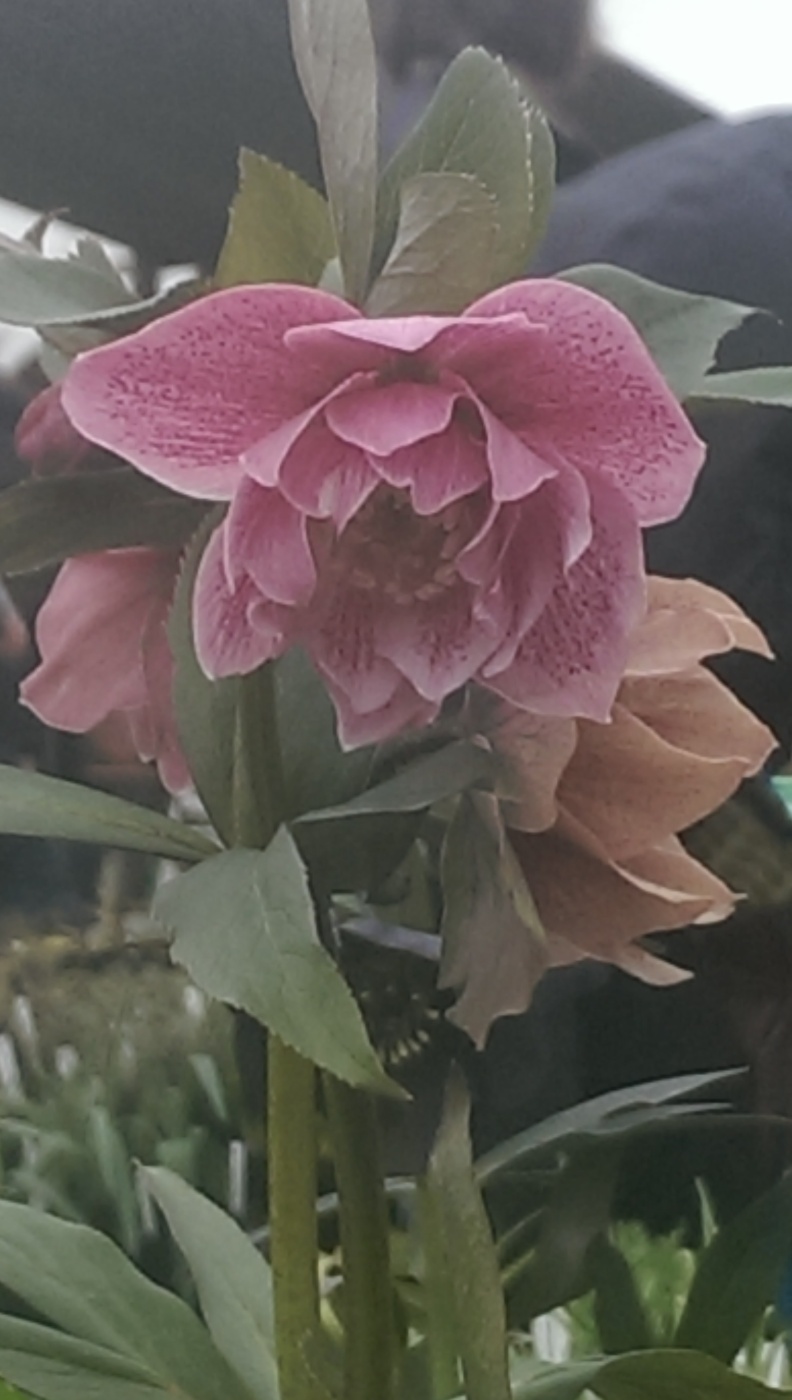
THIS is the hellebore that if I could only pick one is the one though, it’s gorgeous picotee edge, delicate colouring and the shape, wonderful…

Hellebores are subject to a few odd myths, apparently they are used in the summoning of devils, who knew, they have also been used to “cure madness” but honestly I don’t think I’d try either!
Theres a couple of important things to remember with this type of hellebore, come December cut all the leaves off, completely. Be very careful not to damage the flowering spike which will just be starting to emerge. The reason we do this is threefold.
- To prevent infection from fungal diseases such as Hellebore leafspot, this not only looks awful turning the old leaves black in splotches but can also given the chance mar the flowering spike. By removing old leaves you are removing the chance of fungal spores spreading but remember dont compost them otherwise they will just return!
- Removing the leaves prevents a wee timorous beastie from hiding under them and making a feast of your flowers! For mice, hellebore flowers are a valuable source of food. Removing the leaves makes it more difficult for them to use them as camouflage from predators.
- Removing the leaves allows us to appreciate the beauty of these winter treats with an unencumbered view and does the plant no harm, so make this one of your December “To-Do’s”

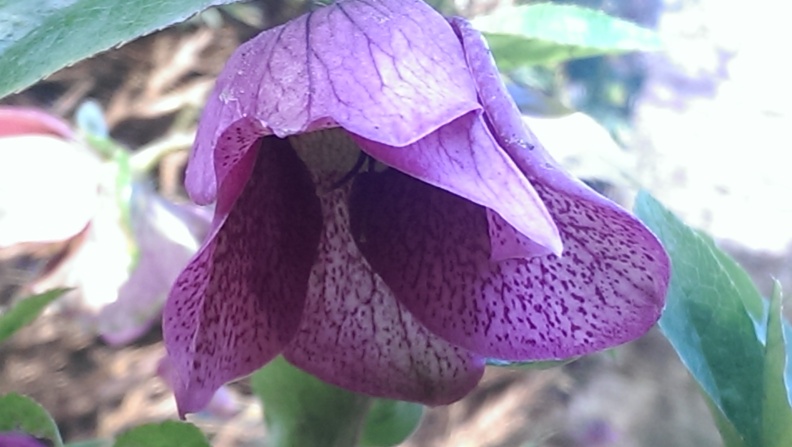

Iris

Finally we reach the wonderful, delicious Iris. Unlike the summers blousy displays of bearded Iris the delicate Iris reticulata, the dwarf Iris, gives a show which bewitches and enchants all in its own right. Originating in Russia it’s well able to thrive in cold conditions but appreciates having dry feet through the summer. Once established you will find that flowering will improve with a hot dry summer, which mimics it’s natural environment. Planted in a south-facing border will also increase the flower power. 
I would recommend planting en masse if at all possible, 1 or 2 in a pot look fine but in a border they can very quickly get lost and lose their impact


Climbers
Clematis Cirrhosa

If I had to pick just 1 climber to include in the winter garden forget Jasminum nudiflorum – Winter Jasmine, its acid yellow flowers are too much for me and lets face it you see it everywhere but consider this gorgeous alternative. A gentle lemony scent accompanies these understated freckled bells. As if these weren’t enough to recommend this wonderful plant the flowers are followed by lovely fluffy seed heads which are a great attractant for finches to feed on or birds to use as nest material, amazing!
Grow it against a south-facing wall where the winter sun can encourage it’s scent and enjoy this low maintenance climber throughout the year.
Other things to consider in the winter garden
It’s not just flowers that make a garden interesting in winter though, the gardens bare bones are exposed so when planning consider how it will look when stripped down.

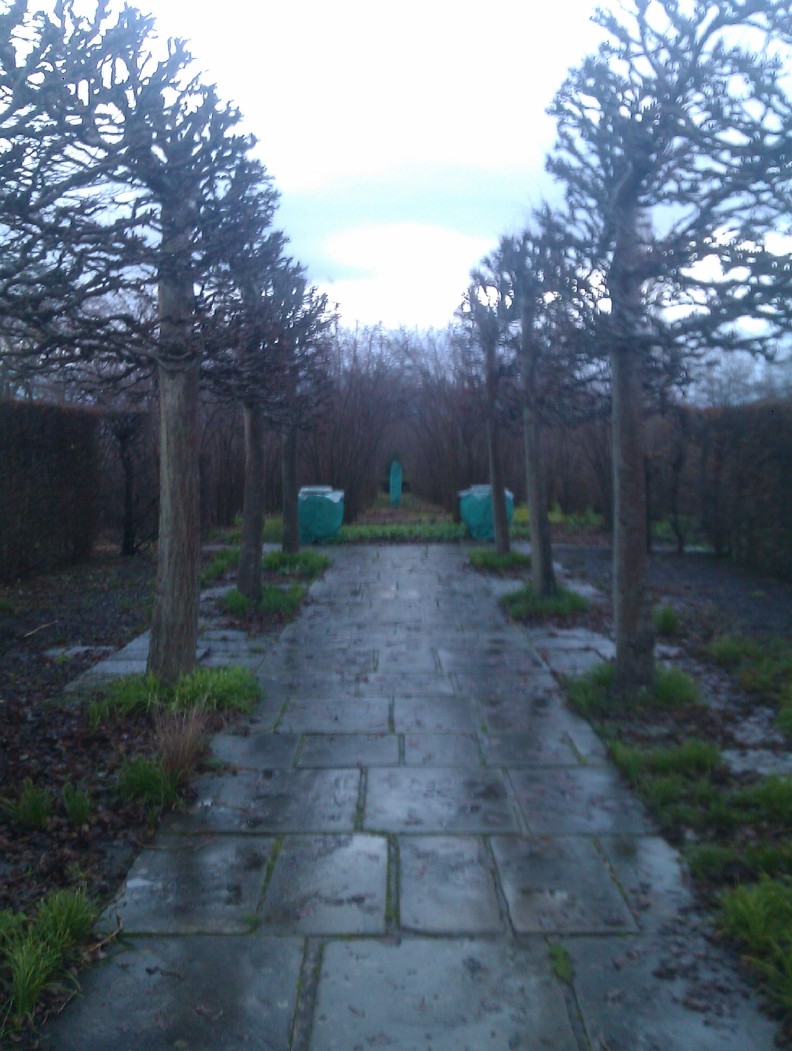
Hedging and topiary are of incredible importance in this situation, they will provide focal points and backdrops that create interest and lead the eye, structures like rose arches and in fact the roses themselves can be used to bring interest if pruned and trained in a creative way. Waterperry’s near Oxford is a great example of how this is done, Sissinghurst adopted these techniques as previous Head Gardeners were trained there. I myself used these techniques at Hole Park.


Consider also how some plants can be used, phlomis and globe artichokes in particular look amazing in the snow.
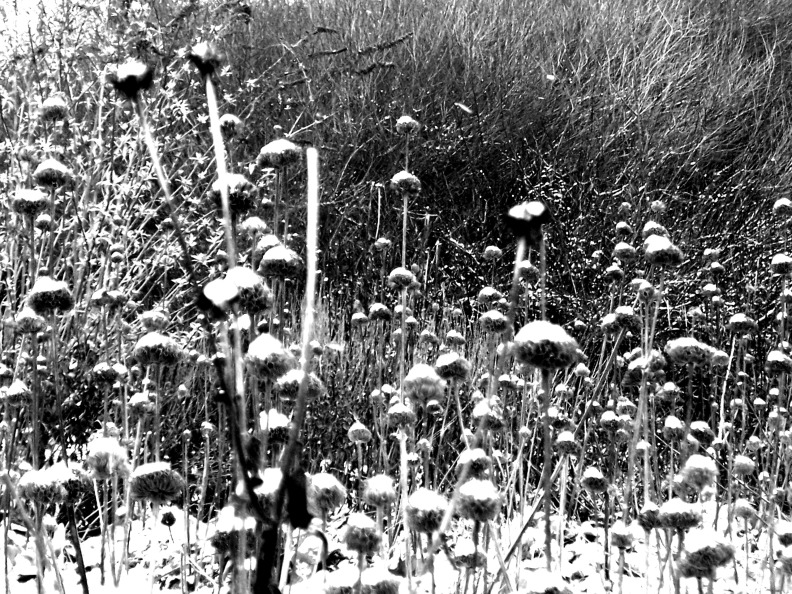

As do grasses, so think about leaving a few things around that can stand till spring to bring movement and structure to your winter landscape.

Finally I’ll leave you with a few of my favourite wintery pics! I’ve got spring seed sowings on my mind now…





Thank you for this great blog post – I love hellebores – only got one in my tiny garden though. Lots of dwarf iris in pots though – never grown snowdrops – must do something about that next winter.
LikeLiked by 1 person
Im so glad you enjoyed! remember to always buy your snowdrops “in the green” as they grow on better that way.
And yes! you MUST get more hellebores! especially the doubles….. then send the babies to me 😉
LikeLike
I’d love some doubles and purple hellebores – I’ll do my best to grow some babies 🙂 – I’ll have to order some ‘in the green’ snowdrops from a proper nursery (I think I bought them from somewhere random like Morrisons)
LikeLike
Theres some fantastic snowdrop fairs being held all over the uk in the next month, id really recommend going along, passionate knowledgable people with unusual varieties!
LikeLike
Ah thank you – I’ll have a look (I live in Salford – so must be some near me)
LikeLike
This is close-ish to you http://www.rodehall.co.uk/
LikeLike
ah brill – I’ve never been there 🙂 will make a plan to visit
LikeLike
Thank you, Lou. Informative and interesting. It has set my gardening juices flowing again. Will look out for that picote hellebore.
LikeLiked by 1 person
If you find it do let me know 😉
LikeLike
Great blog, will have to reread at least a couple of times more as there is so much information here. Will you write about the training of roses as a feature? Interested to know more about it. Well done
LikeLiked by 1 person
Thank you and what a great idea! I’ll be visiting Waterperry’s at the end of the month, i’ll take some time out to photograph how they do theirs. winter is the best time as you can see exactly how its done 🙂
LikeLike